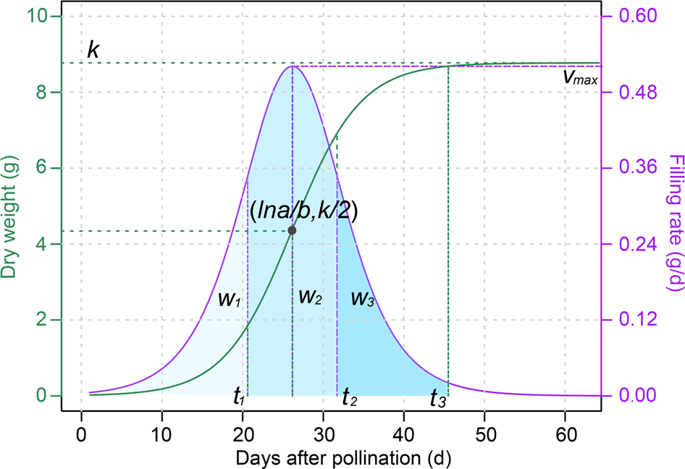Our official English website, www.x-mol.net, welcomes your feedback! (Note: you will need to create a separate account there.)
Genetic and genomic analysis of the seed-filling process in maize based on a logistic model
Heredity ( IF 3.8 ) Pub Date : 2019-07-29 , DOI: 10.1038/s41437-019-0251-x Shuangyi Yin 1 , Pengcheng Li 1 , Yang Xu 1 , Jun Liu 1 , Tiantian Yang 1 , Jie Wei 1 , Shuhui Xu 1 , Junjie Yu 1 , Huimin Fang 1 , Lin Xue 2 , Derong Hao 2 , Zefeng Yang 1 , Chenwu Xu 1
Heredity ( IF 3.8 ) Pub Date : 2019-07-29 , DOI: 10.1038/s41437-019-0251-x Shuangyi Yin 1 , Pengcheng Li 1 , Yang Xu 1 , Jun Liu 1 , Tiantian Yang 1 , Jie Wei 1 , Shuhui Xu 1 , Junjie Yu 1 , Huimin Fang 1 , Lin Xue 2 , Derong Hao 2 , Zefeng Yang 1 , Chenwu Xu 1
Affiliation

|
Seed filling is a dynamic process that determines seed size and nutritional quality. This time-dependent trait follows a logistic (S-shaped) growth curve that can be described by a logistic function, with parameters of biological relevance. When compared between genotypes, the filling dynamics variations are explained by the differences of parameter values; as such, the parameter estimates can be considered as “traits” for genetic analysis to identify loci that are associated with the seed-filling process. We carried out genetic and genomic analysis of the seed-filling process in maize, using a recombinant inbred line (RIL) population derived from the two inbred lines with contrasting seed-filling dynamics. We recorded seed dry weight at 14 time points after pollination, spanning the early filling phases to the late maturation stages. Fitting these data to a logistic model allowed for estimating 12 characteristic parameters that can be used to meaningfully describe the seed-filling process. Quantitative trait locus (QTL) mapping of these parameters identified a total of 90 nonredundant loci. Using bulked segregant RNA-sequencing (BSR-seq) analysis, we identified eight genes that showed differential gene expression patterns at multiple time points between the extreme pools, and these genes co-localize with the mapped QTL regions. Two of the eight genes, GRMZM2G391936 and GRMZM2G008263 , are implicated in starch and sucrose metabolism, and biosynthesis of secondary metabolites that are well known for playing a vital role in seed filling. This study suggests that the logistic model-based approach can efficiently identify genetic loci that regulate dynamic developing traits.
中文翻译:

基于逻辑模型的玉米灌浆过程的遗传和基因组分析
种子灌浆是决定种子大小和营养质量的动态过程。这种时间依赖性特征遵循逻辑(S 形)生长曲线,可以通过逻辑函数描述,具有生物学相关性参数。在基因型之间进行比较时,填充动态变化可以通过参数值的差异来解释;因此,可以将参数估计值视为遗传分析的“特征”,以识别与种子灌浆过程相关的基因座。我们使用源自具有对比种子灌浆动态的两个自交系的重组自交系 (RIL) 群体对玉米的种子灌浆过程进行了遗传和基因组分析。我们在授粉后的 14 个时间点记录种子干重,跨越早期灌浆阶段到成熟后期。将这些数据拟合到逻辑模型可以估计 12 个特征参数,这些参数可用于有意义地描述种子填充过程。这些参数的数量性状基因座 (QTL) 作图确定了总共 90 个非冗余基因座。使用批量分离 RNA 测序 (BSR-seq) 分析,我们确定了八个基因,这些基因在极端池之间的多个时间点显示出差异基因表达模式,并且这些基因与映射的 QTL 区域共定位。八个基因中的两个,GRMZM2G391936 和 GRMZM2G008263,与淀粉和蔗糖代谢以及众所周知在种子灌浆中起重要作用的次生代谢物的生物合成有关。该研究表明,基于逻辑模型的方法可以有效地识别调节动态发育性状的遗传基因座。
更新日期:2019-07-29
中文翻译:

基于逻辑模型的玉米灌浆过程的遗传和基因组分析
种子灌浆是决定种子大小和营养质量的动态过程。这种时间依赖性特征遵循逻辑(S 形)生长曲线,可以通过逻辑函数描述,具有生物学相关性参数。在基因型之间进行比较时,填充动态变化可以通过参数值的差异来解释;因此,可以将参数估计值视为遗传分析的“特征”,以识别与种子灌浆过程相关的基因座。我们使用源自具有对比种子灌浆动态的两个自交系的重组自交系 (RIL) 群体对玉米的种子灌浆过程进行了遗传和基因组分析。我们在授粉后的 14 个时间点记录种子干重,跨越早期灌浆阶段到成熟后期。将这些数据拟合到逻辑模型可以估计 12 个特征参数,这些参数可用于有意义地描述种子填充过程。这些参数的数量性状基因座 (QTL) 作图确定了总共 90 个非冗余基因座。使用批量分离 RNA 测序 (BSR-seq) 分析,我们确定了八个基因,这些基因在极端池之间的多个时间点显示出差异基因表达模式,并且这些基因与映射的 QTL 区域共定位。八个基因中的两个,GRMZM2G391936 和 GRMZM2G008263,与淀粉和蔗糖代谢以及众所周知在种子灌浆中起重要作用的次生代谢物的生物合成有关。该研究表明,基于逻辑模型的方法可以有效地识别调节动态发育性状的遗传基因座。


























 京公网安备 11010802027423号
京公网安备 11010802027423号